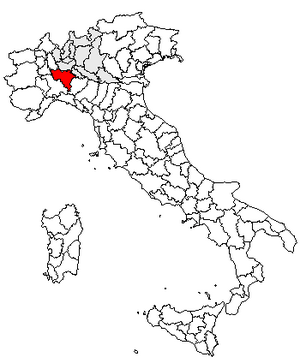Province of Pavia facts for kids
Quick facts for kids
Province of Pavia
Pavia
|
|
|---|---|
 |
|
| Country | |
| Region | Lombardy |
| Capital | Pavia |
| Area | |
| • Total | 2,965 km2 (1,145 sq mi) |
| Population
(2001)
|
|
| • Total | 493,829 |
| • Density | 167/km2 (430/sq mi) |
| Postal Code |
27010-27027, 27029-27030, 27032, 27034-27055, 27057-27059, 27100
|
| Telephone prefix |
0381, 0382, 0383, 0384, 0385
|
| ISTAT | 018 |
| Vehicle registration | PV |
| No. of communes | 190 |
The Province of Pavia (in Italian, Provincia di Pavia) is a special area in northern Italy. It is part of the Lombardy region. The main city and capital of this province is Pavia. In 2015, about 548,722 people lived here. The province covers an area of about 2,968 square kilometers (1,146 square miles). The city of Pavia itself has about 72,205 residents.
Contents
History of Pavia Province
The city of Pavia has a very long history. It was first settled by a group of people called the Ligures. Later, Gaulish tribes lived there.
Ancient Times and Roman Rule
The Romans conquered Pavia in 220 BCE. They called the town "Ticinum". The Romans made it stronger to help protect northern Italy. However, the town was attacked by Attila the Hun in 452 CE. Attila was a powerful ruler of the Huns. Later, in 476 CE, Odoacer attacked it again.
Lombard Kingdom and Frankish Rule
In the 500s, Pavia became the capital city for a German tribe called the Lombards. They tried to fight off an invasion by the Franks. But after the death of Charlemagne, the Lombard lands became part of the Frankish kingdom.
Becoming a Commune
In the 1100s, after the Franks left, Pavia became a "commune." This means it was a self-governing town. Frederick I, Holy Roman Emperor made parts of the commune stronger. He was crowned in Pavia in 1155. The famous University of Pavia was started in 1361.
Spanish Control and Important Battles
From 1359, the Visconti and then the Sforza families from Milan owned Pavia. But in 1499, the Duchy of Milan became part of Spain. In 1525, a big battle happened in Pavia. Charles V, Holy Roman Emperor defeated Francis I of France there. This was a very important event in European history.
Later, in 1707 and 1774, some parts of the "principality of Pavia" were sold to Piedmont. These changes were undone after the French Empire fell in 1814.
Geography of Pavia Province
The Province of Pavia is located in the Lombardy region of northwestern Italy.
Borders and Rivers
It shares borders with several other provinces:
- To the north: Milan and Lodi
- To the southeast: Province of Piacenza (in Emilia-Romagna)
- To the southwest: Province of Alessandria (in Piedmont)
Two major rivers, the Ticino and the Po, flow through the province. They meet about four kilometers south of the capital city, Pavia. The River Po can be used by boats up to where it meets the Ticino. Another large river in the province is the Olona.
Regions of the Province
The province has 190 communes (small towns or districts). It is divided into three main regions:
- The Pavese: This area is completely flat and is part of the Po Valley.
- The Lomellina: This region is also flat and in the Po Valley. It lies between the Ticino and Po rivers.
- Oltrepò: This area is south of the Po River. It includes Monte Lesima, a mountain in the Apennine Mountains. Monte Lesima is 1,724 meters (5,656 feet) high and is the highest point in the province.
The area called Siccomario, where the two big rivers meet, is historically considered part of Pavese, even though it's geographically similar to Lomellina.
Landscape and Economy
Most of the province is flat. The northwestern part has very good land for farming. The southern part of the province has low hills that eventually lead to the Ligurian Apennine Mountains.
The city of Pavia is important for Italy's textile industry. It is also well-known for making hats. The province also has engineering and metal industries. This area is very important for making wine, especially sparkling wines. It is the largest area in Italy that produces Pinot noir grapes.
See also
 In Spanish: Provincia de Pavía para niños
In Spanish: Provincia de Pavía para niños

